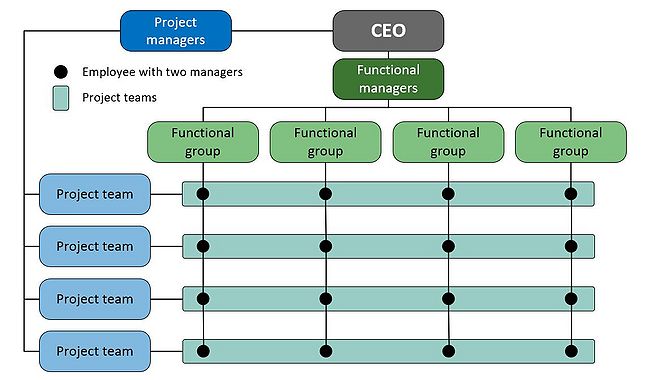Managing projects in a functional organization
(→Organizational structure) |
(→Abstract) |
||
| Line 3: | Line 3: | ||
= Abstract = | = Abstract = | ||
| − | + | Functional organisations, where the employees are grouped based on skills and job type, are useful to increase knowledge sharing within the groups. I.e. a functional group with programmers allows the programmers to help and learn from one another during working hours. This results in more specialized groups with self-increasing skills, though limiting the connection between people with different skill sets. Divisional organisations, where the employees are divided into groups based on location, product or market instead, have a broad variety of people with different skills in each group. This allows for better interactions among the different skill sets during working hours, but takes away the knowledge sharing with like-minded people. | |
<ref> | <ref> | ||
J. M. G. Gareth R. Jones, Essentials of Contemporary Management, Sixth edit. New York, NY 10121: McGraw-Hill Education, 2015. | J. M. G. Gareth R. Jones, Essentials of Contemporary Management, Sixth edit. New York, NY 10121: McGraw-Hill Education, 2015. | ||
| − | </ref> | + | </ref> |
| + | |||
| + | Projects are generally complex and require people with various skills to be done. Thus, the divisional organisation structure seems like the better fit for projects, as the need for inter-group communication is far less crucial. In a functional organization, all groups involved with the project have to be in close communication with one another in order to maintain a common direction for the project. This is where the project manager becomes important. | ||
| + | |||
| + | This article highlights the common challenges that a project manager must deal with when doing projects in a functional organization. | ||
= Introduction = | = Introduction = | ||
Revision as of 12:11, 18 February 2019
Contents |
Abstract
Functional organisations, where the employees are grouped based on skills and job type, are useful to increase knowledge sharing within the groups. I.e. a functional group with programmers allows the programmers to help and learn from one another during working hours. This results in more specialized groups with self-increasing skills, though limiting the connection between people with different skill sets. Divisional organisations, where the employees are divided into groups based on location, product or market instead, have a broad variety of people with different skills in each group. This allows for better interactions among the different skill sets during working hours, but takes away the knowledge sharing with like-minded people. [1]
Projects are generally complex and require people with various skills to be done. Thus, the divisional organisation structure seems like the better fit for projects, as the need for inter-group communication is far less crucial. In a functional organization, all groups involved with the project have to be in close communication with one another in order to maintain a common direction for the project. This is where the project manager becomes important.
This article highlights the common challenges that a project manager must deal with when doing projects in a functional organization.
Introduction
Pending...
Organizational structure

Divisional departmentalization
Pending...
Functional departmentalization
Pending...
Project management in functional organizations
Pending...